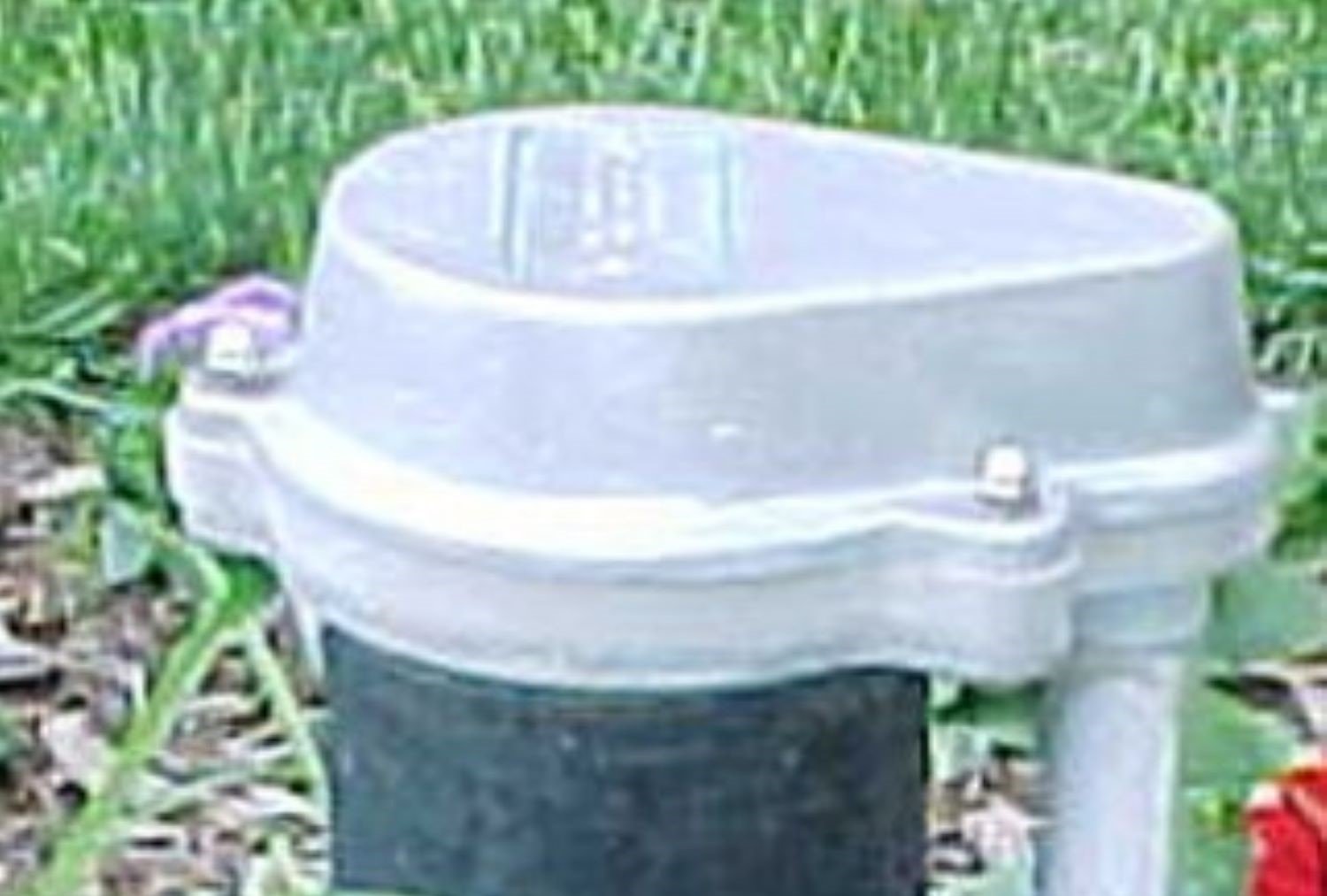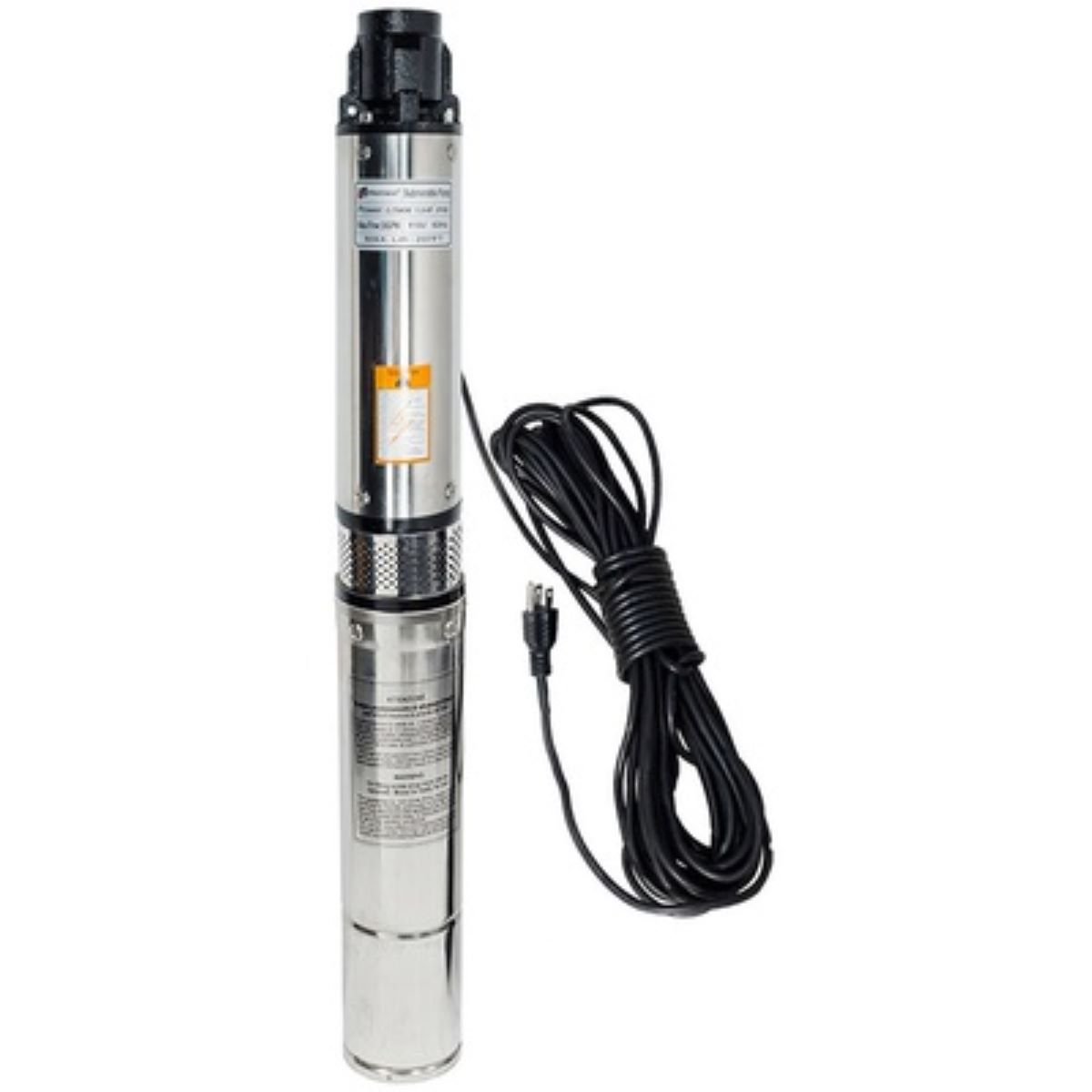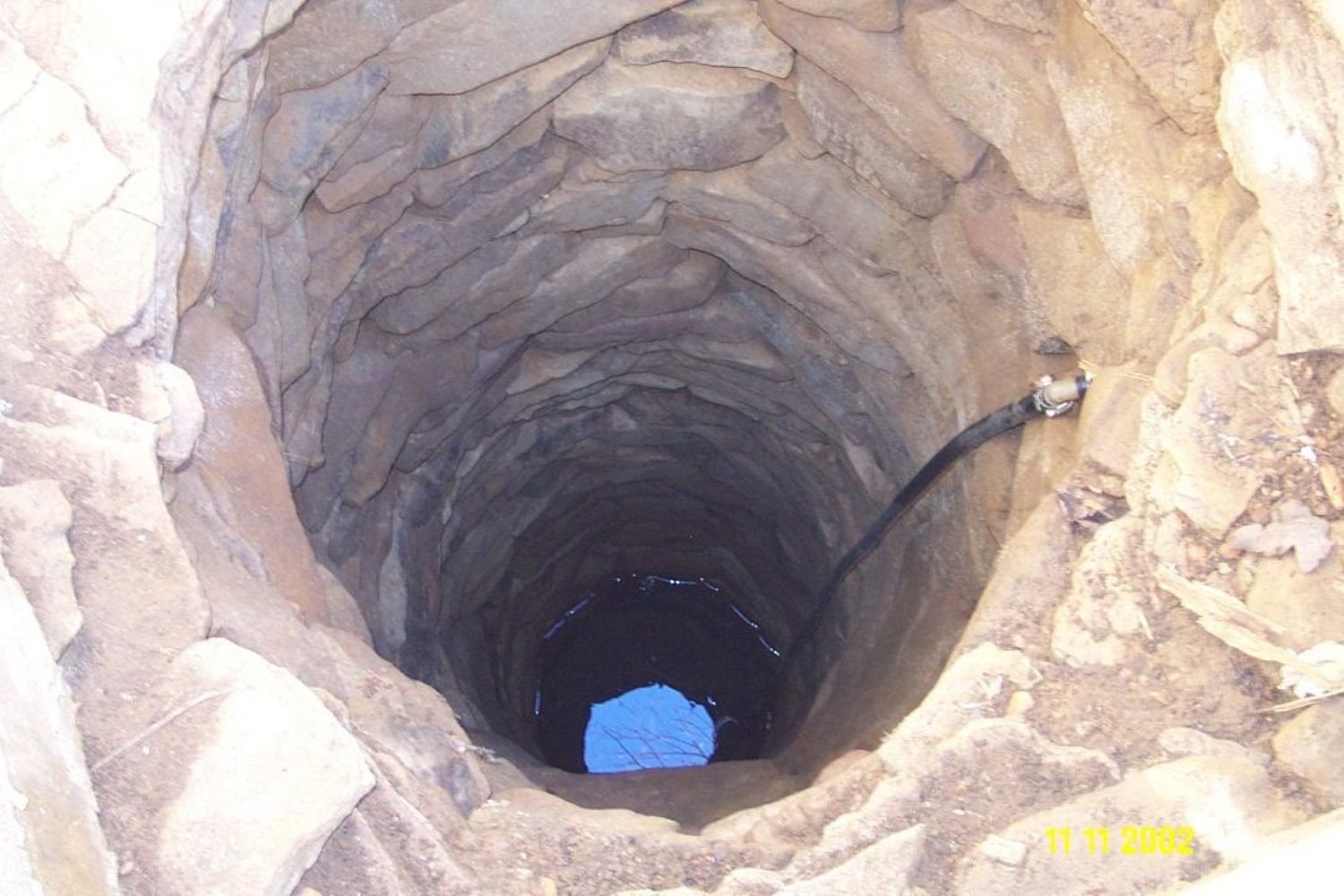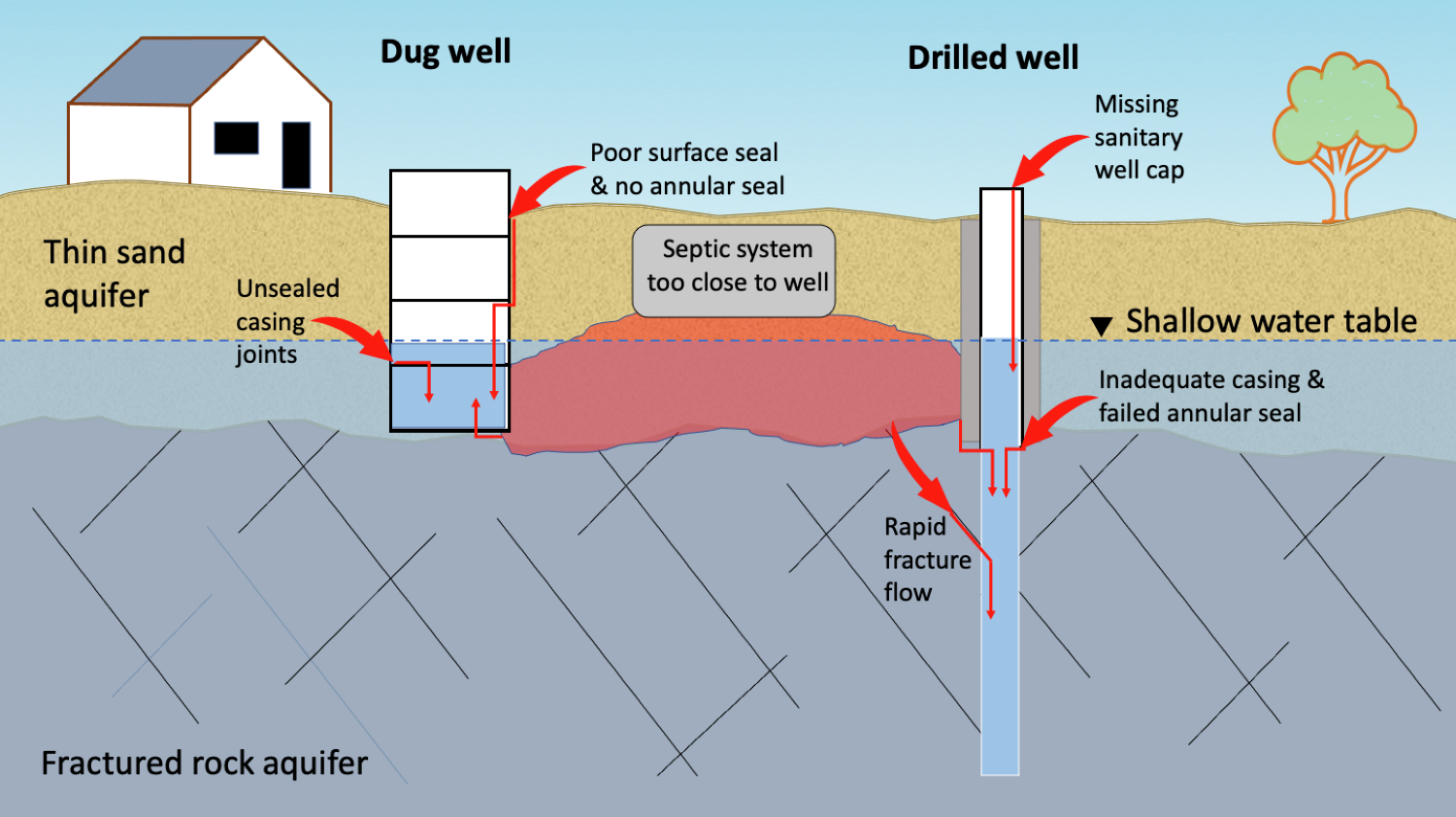Water Well in Basement of Old House (Explained)
by JSL
We Almost Bought an Old Home with a Water Well in the Basement (What We Learned)
We were recently touring a property and were considering buying it with an all-cash offer and a quick closing. This older home needed a lot of work, but that is typical of the homes we buy.
As we walked into a large addition off the back of the home, we noticed a very unusual opening in the carpeted floor.
Strange Hole in Carpeted Floor
Entrance to Old Water Well in Basement
We definitely did not expect to see a basement filled with water and what turned out to be a water well in the basement of this house, complete with a well pump, well cap, electrical and other well components. Until recently, the well inside this house had been used to provide water for drinking, cooking and cleaning throughout the home.
Water Well Pit in Basement Visible
Close Up of Old Basement Water Well
Naturally, we had to find out more about the implications of this discovery on our potential cash offer for the home.
TABLE OF CONTENTS
What are Basement Water Wells?
o Driven
o Drilled
o Dug
Are Old Basement Wells Dangerous?
- Contamination from Outside Elements
- Contamination from Interior Elements
- Legality in Our City
- Legality in Our State
- Legality in Other Parts of the Country
Can you Sell a Home with an Old Well in the Basement?
- One Big Roadblock for Buyers
- Local Government Violations
Replacing a Basement Well (Options)
- Abandoning/Decommissioning an Old Well: Process and Cost
What is a Water Well in the Basement?
In the simplest of terms a basement well is a hole within the footprint of a home, located in a basement, established by any of the construction methods described below, and that reaches ground water. Through use of a pumping system and plumbing, the ground water is pumped out of the basement well and can be circulated for use throughout the home.
While most of us may be accustomed to public water supplied by our local water utility companies, private wells are a common source of private water for homes throughout the United States. It is less common, however, to have a well like this one inside the basement of a home.
In the present time, newer wells that serve as a private water source for a home are normally established outside of the footprint of a house.
In fact, the old basement well we ran into above was not originally located inside the home. The prior owners had simply decided to expand their home and built the addition directly on top of their previously outdoor well.
Primary Well Components
Private wells (whether in basements or outside of the home) will generally contain the following components:
(1) Casing
The tube structure that runs from the surface of the ground down to the groundwater and which, depending on the type and age of well, may be constructed of steel, pvc, brick, tile or other materials.
Old Metal Casing
Newer PVC Casing
(2) Cap
Blue Well Cap
Gray Well Cap
A tight-fitting vented seal on top of the well opening, which should extend a minimum of 12 inches above the ground.
(3) Screens
Located where the water will enter the casing and designed to act as a filter to prevent debris and material from entering the well.
Perforated Well Screen
Mesh Screen
Well Screen
(4) Adapter
A freeze-proof seal right where the casing connects with the plumbing that will bring the well water into the home.
New Uninstalled Pitless Adapter
Sketch of Installed Pitless Adapter
(5) Pump and Electrical for Pump
“Submersible” (located below the surface of the well water) or “jet” (located on the surface of the ground) electrical pumping systems that brings the water from below ground to the surface.
Submersible Well Pump
Jet Well Pump
Typical Well Construction Methods
Any well you come across may have been established and constructed through one of a few different methods.
Well Construction Methods
Drilled Well
The groundwater may be reached and the private well established in deep locations (over 1,000 feet deep) through powerful rotary drills (“drilled wells”) which require the use of special casing, sealing material and screening to prevent contamination of the well water and insure structural stability of the well.
When compared to other types of wells, drilled wells have a lower risk of contamination due to their depth and method of construction.
Drilling a Well
Driven Well
A private well may be established in shallower locations (up to 50 feet deep) when the groundwater is closer to the surface (within around 15 feet of ground level), by driving metal piping with a screen called a “well point” on the end of it into the ground (a, “driven well”).
Driven wells have a higher risk of contamination than drilled wells, but a lower risk of contamination than dug wells.
Dug Well
Finally, the well may be very shallow (10-30 feet deep) if established by more rudimentary digging. These shallow wells can simply be holes dug into the ground with shovel or hoe and lined with material like stone or brick for structural integrity (a “dug well”).
Dug wells have the highest risk of contamination of the three types of wells described here.
A basement well can be a drilled well, driven well or a dug well that was either originally placed in the basement of a home, or which was originally outside of the home and the home was later expanded over the well.
Dug Well
Are Old Basement Wells Dangerous?
The basement well shown above in the home that we almost purchased was unsafe. The pumping system had failed, water had been stagnant above the well cap for some time, mold was growing throughout the basement and there were serious signs of wood rot in the subfloor above the well.
All these unsafe elements of the well in this basement occurred simply because the owners had failed to maintain it.
Sources of Well Contamination
Contamination from Outside Elements
Water can of course become contaminated no matter where it is located. However, basements are often a source of concern whenever we buy a property even when they are not the location of a home’s main source of water for drinking, cooking and cleaning.
Basements are prone to dampness which can produce mold and rot. Basements are never the cleanest part of a home and are subject to flooding in storms. Basements also often contain exposed sewer stacks and wastewater plumbing that carries wastewater from the upper floors of the home into the below ground main sewer line. When sewer lines back up, we typically first see the backup in the basement.
For all these reasons, one can understand why it poses a safety risk to have the main access point to your source of drinking and cleaning water in the basement. If wastewater, mold, basement critters and other basement muck were to make their way into the well, the consequences could be serious and costly.
Moreover, it is not just contamination of the home’s own drinking and cleaning water that is at issue.
When contaminants enter a well, particularly a drilled well that may reach all the way down to an aquifer shared by multiple homes, it is possible that the source of water for neighboring properties will also become contaminated. This poses both a health risk and a liability risk.
This risk of contamination is one of the main reasons why, as discussed below, many local governments frown upon wells in basements. This means that basement wells can lead to more government involvement in a renovation and higher costs (and stress) for us as buyers and/or owners of the home.
Contamination from Interior Elements
Wells that are not maintained, and particularly older wells like the one we found above, may also contain deteriorating components (e.g. corrosion of old metal casing). That corrosion can both leech into the well water and also create buildup that makes it harder to extract water from the well and/or damages other well components.
Very old well screens can also fail, allowing previously filtered debris and material to enter the well.
Just like contamination from the exterior elements described above, the failure of these interior well components can lead to contamination of well water.
Are Old Basement Wells Legal?
We give many details on this below, but the answer to this question is, frustratingly, “it depends.” The answer will not be consistent between different municipalities because each local government throughout the United States can have their own set of rules and regulations governing basement wells.
Additionally, some state and local governments answer this question with clear and concise regulations that you can find through a simple google search.
Others, including the county health district in charge of private wells where our property-of-interest was located, had to be called directly to obtain an answer.
Legality in Our City
When we spoke with the county health district representative responsible for private well regulation where our property-of-interest was located, they explained the following:
(1) This particular city and county would only become involved with a private well if:
a. the property owner asked for an inspection of the well;
b. a buyer wanted an inspection of the well completed before a purchase; or
c. work was being done to the well that required a permit.
In other words, this city and county would not investigate a basement well to determine if it was legal and up to code unless specifically asked for an inspection.
If they were asked to complete an inspection of the well, the county health department would inspect the well, take a sample of water and test it for bacteria.
If the results showed that the bacteria levels were too high, the county could decide that the basement well was not legal.
This decision would result in the need to abandon the well (see more about abandoning a well below).
(2) While the city and county would not determine legality of the well in the absence of a request for an inspection, there was a legal requirement in this city that if the home was ever connected to the public water supply, the basement well would have to be abandoned/decommissioned.
In such a scenario, the county inspectors would be involved to ensure that the well abandonment process was completed properly.
In other words, it is not legal in this city to have a connection to public water and maintain a well in the basement.
(3) The county health department also informed us of something very interesting, which highlights just how important it is for you to check with your specific city and county regarding the legality of a well in the basement.
Just one city over from where our property-of-interest was located, private wells are completely prohibited regardless of whether they are in a basement or outside of the home.
This other city changed their laws to require that every home connect to the city’s public water supply system.
In other words, this basement well would have absolutely been illegal if it was in a house just a few blocks away where the other city boundary began.
Note: We are not lawyers and are not providing legal advice for your specific situation, so please consult an attorney in your state regarding basement well requirements.
Legality in Our State
In addition to the city and county, the state in which our property-of-interest was located has some specific regulations governing wells located in basements. When we reviewed those regulations, we found that the basement well we came across above was not in compliance.
Our state requires that wells in basements be properly ventilated to the exterior, which means: (i) a three inch or larger vent pipe, (ii) the vent pipe extending at least ten feet away from the home’s foundation, (iii) the vent pipe being at least 18 inches above the ground surface, and (iv) the end of the vent pipe facing downward and being properly screened.
The basement well we ran into did not satisfy these requirements.
As you can see, the legal requirements governing basement wells can be highly specific, increasing the risk of non-compliance and therefore making it more difficult for a prospective home buyer.
Note: We are not lawyers and are not providing legal advice for your specific situation, so please consult an attorney in your state regarding basement well requirements.
Legality in Other Parts of the Country
Some states, like the State of Wisconsin, have prohibited the construction of wells in basements for 70 years (since 1953)!
Even if a homeowner can prove that their old basement well was constructed before Wisconsin’s specified cutoff date of 1953, a basement well will still be considered illegal if (i) it is too shallow, (ii) it is too close to a sewer line, (iii) the basement is unsanitary, (iv) water testing reveals unclean water or (v) the basement well poses a risk to the groundwater.
Other states, like Minnesota, specify that there is no requirement for a well to be compliant with state law at the time a property is sold, but (and here is the kicker) if anyone was to make any modifications to an old non-compliant well (for example, to replace a bad well screen), the entire well might then have to comply with current law.
Current law in Minnesota does not allow wells to be constructed inside a building or for a building to be built over a well. Therefore, if your basement well needed a new well screen, you may be required to abandon the basement well entirely and install a new outdoor well (which is very costly, see below).
The general point here is that having a well in a basement creates some potential legal and regulatory headaches that you need to understand.
Note: We are not lawyers and are not providing legal advice for your specific situation, so please consult an attorney in your state regarding basement well requirements.
Can You Sell a Home with an Old Well in the Basement?
One Big Roadblock for Buyers
Most home buyers will be using financing (i.e. a loan) to purchase a home, and this fact brings us to a primary concern when trying to sell a home with a well in the basement.
A very large support for home loans is the Federal Housing Authority (FHA) and the FHA has said this which applies to basement wells:
An existing property, which is serviced by a well located within the foundation walls of the dwelling, is acceptable as security for FHA-insured financing only when the local jurisdiction recognizes and permits such a location. A well located within new construction is not acceptable except in arctic or sub-arctic regions.
So, for starters, one major source of support for a potential buyer of a home with a well in the basement may not be available unless the city and county in which the home is located approve of the well’s location in the basement.
In addition, loans that come from non-FHA lenders (“conventional loans”), can have their own requirements and restrictions relating to basement wells. Accordingly, any buyer will need to check with their specific lender to confirm whether the basement well is acceptable.
Any time the pool of potential home buyers is limited it will be more challenging to sell a home, and clearly what we have here with wells in basements is a potential limiting of the number of people who can buy the home.
Local Government Code Violations
Whenever buyers are deciding whether to purchase a home, they (or their realtor) will frequently be on the lookout for any potential code violations connected to the home. This is of course in addition to just generally looking for potential sources of problems and headaches associated with the home. Home buyers may also reach out to the city and/or county to find out if there are any existing code violations within the government’s database.
As discussed above, there are many different code requirements associated with private wells, and there are particularly strict requirements when it comes to wells located in a home’s basement.
Accordingly, a basement well may become a sticking point for home buyers if not brought into compliance with local code requirements. Unfortunately, in some jurisdictions that may mean that the old well needs to be decommissioned entirely and a new water source established. It may alternatively mean making repairs to the basement well.
In either case, it is likely that the buyer will either ask for a credit to repair or decommission (if required) the well or ask the seller to do so before the sale closes.
Abandoning an Old Water Well: Process and Cost
Due to the serious issues with the basement well we found, and due to our own preference to be connected with city water, our best option would have been to decommission the old well.
Decommissioning an old well in this particular city requires a few things:
(1) Notifying the local Environmental Protection Department;
(2) Obtaining a permit to seal up the well;
(3) Hiring a private water systems contractor who is (i) familiar with the city’s, county’s and state’s specific requirements for sealing private wells, and (ii) who can obtain the permit to do so;
(4) Removing all pumps, pipes and other equipment from the well; and
(5) Using a specialized sealing material (typically one called bentonite which is a material that expands as much as 13 times its dry size when made wet and is mixed with cement) to seal up the well.
We obtained three different quotes to determine what it might cost to decommission the basement well, which quotes included all five of the items listed above. The quotes ranged from $1,250.00 - $3,000.00 but keep in mind, this city is in the Midwest where labor (and pretty much everything) is much cheaper than other parts of the United States.
Depending on where you live the cost could be much higher, but these prices may represent the floor of what you might pay.
Connecting to City Water: Process and Cost
As we were serious about making a cash offer on this property and closing quickly, we needed to find out about our options for providing water to the home following a decommissioning of the basement well.
Luckily, the street in front of the home did have public water running through it so we had the option to connect to public water.
We reached out to contractors to determine the cost, and the quotes ranged from $4,500.00 - $6,000.00 with a big “it depends on….” connected to that price range.
The big potential turning point in the pricing was that some cities permit the use of pvc piping to connect the home to the city water. Other cities, however, require the use of copper piping.
As copper is far more expensive than PVC, we would have had to pay much more if the city required copper. Luckily, we were able to confirm that this particular city would not require copper plumbing lines. This highlights again the importance of speaking to your city about their specific requirements when it comes to decommissioning a well in the basement.
There is another very important cost-related item to keep in mind. The quotes we received were based on the number of feet between the public water connection point and the house.
In other words, if you have a home with an incredibly long driveway to the public street, you will pay a lot more than someone who has a home that is very close to the public street. This price difference is due to the simple fact that there is more work and more materials involved in running longer plumbing lines.
Establishing a New Water Well: Process and Cost
As an alternative to connecting to the public water system in the street in front of the home, we did have the option to establish a new well outside of the home in this city. This would have involved constructing a drilled well, which is described in more detail above.
We knew we would only be interested in this option if the cost savings was substantial when compared to connecting to city water. That is because we believe that most home buyers, including us and anyone we might sell to in the future, do not prefer the idea of having to maintain a private well, repair it when components break, and being concerned about potential contamination of the home’s only water source.
Many people may like the idea of a private well and living “off-the-grid” but in our experience, that perspective is not the majority of home buyers who like to keep things as simple as possible.
With the above in mind, when we started getting quotes in excess of $14,000.00 for a new drilled well installation, our decision was quite easy. If we were to buy this home, we would definitely connect to city water.
In the End….
In the end, after all of that work, we did not purchase this home. When we completed the renovation budget, including the potential costs associated with decommissioning the basement well and establishing the new public water connection, the numbers just did not make sense.
However, this was an incredibly valuable exercise in terms of understanding the implications of a perhaps rare, but still possible, circumstance of a finding a well in the basement of a home.
Josh has been a real estate investor since 2011, and owns/operates single-family, multifamily, and commercial real estate in multiple markets in Northeast Ohio with his wife and partner, Elina. When they are not onsite managing construction projects, getting their hands dirty fixing things, and touring neighborhoods and properties, Josh and Elina can be found walking in the Metroparks, enjoying ice cream at Mitchell’s, pretending to work out at LifeTime Fitness and traveling.
Sources:
https://www.epa.gov/privatewells/learn-about-private-water-wells
https://codes.ohio.gov/ohio-administrative-code/rule-3701-28-10
https://dnr.wisconsin.gov/topic/Wells/basementPit.html
© All content copyright LP Property Group 2019-2022





















